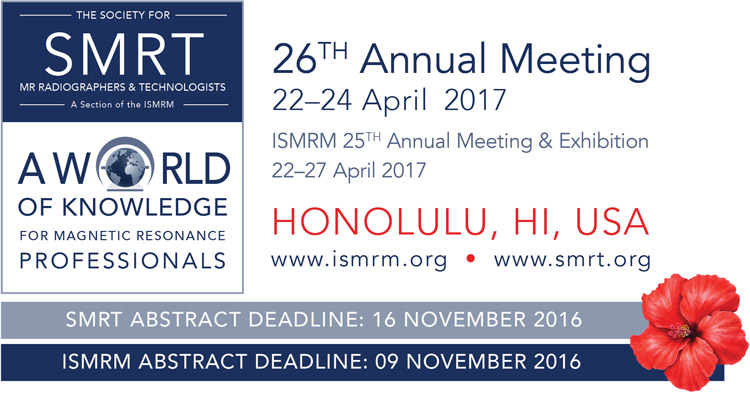
Guidelines for Traditional Posters & On-Site Presentations
SMRT 26th Annual Meeting, Honolulu, Hawai’i, USA
A poster presentation combines a visual display of the highlights of research with a question-and-answer opportunity at a specified time.
Schedule:
The SMRT Annual Meeting will be held in the Hawai’i Convention Center. The SMRT Meeting Room will be available for poster mounting beginning Friday, 21 April at 14:00. Your poster must be mounted by 16:00 Friday, 21 April. The SMRT 26th Annual Meeting Poster Walking Tour will held from 18:00–20:00, Friday, 21 April. Please note that light boxes will not be allowed, and power outlets will not be available.
Measurements:
Each presenter will be allotted a poster space of 91.44 cm Width X 91.44 cm Height (36 inches x 36 inches). Please note the allotted size and be attentive not to exceed these dimensions. Posters exceeding these measurements and extending into areas reserved for other posters will be removed.
Mounting:
Posters should be designed and constructed so they can be attached to the poster board with push pins (pins will be provided by the SMRT). Your poster number and last name will be mounted on the poster board assigned to you.
During Your Session:
Poster authors are required to be present, at their posters, during the Poster Walking Tour Reception to discuss their poster with attendees and answer any questions. A photographer will take your picture with your poster to be included in the E-Signals newsletter.
After Your Session:
Your poster must remain mounted and available for viewing until 17:00 on Sunday, 23 April. If you plan to show your poster at the ISMRM 25th Annual Meeting, Monday through Thursday, 24 – 27 April in the Exhibition Hall, additional instructions will be available to you prior to the Annual Meeting. If you will not be showing your poster at the ISMRM 25th Annual Meeting, you must remove your poster by 17:30 on Sunday, 23 April. Posters not removed will be discarded.
SUGGESTIONS FOR PREPARING TRADITIONAL POSTERS FOR ON-SITE
Content:
- The poster should show the full title of your abstract.
- Text should be brief and well organized, presenting only enough data to support your conclusions.
- The text should make clear the significance of your research.
- The text should include the categories indicated by the focus of your poster, clinical or research, as outlined in the abstract submission instructions.
- Include all references.
Measurements:
Each presenter will be allotted one poster space of 91.44 cm Width X 91.44 cm Height (36 inches x 36 inches). Please note the allotted size and be attentive not to exceed these dimensions.
Design:
- A clear, simple, uncluttered arrangement is the most attractive and the easiest to read.
- The title lettering should be approximately 5cm (2 in.) high, with authors’ names and affiliations in smaller print.
- All lettering should be legible from a distance of 1.5m (5 ft.). The typeface chosen should be a simple and clear one (e.g. Times New Roman or Helvetica). Titles should be in all upper case letters, with the remainder of the text typed in a combination of capital and lower-case letters for ease of reading.
- Color should be used sparingly, and primarily to provide contrast. The featured parts of the poster can be highlighted with warm colors, and the less important parts can be done in cool colors. Some suggestions for color combinations are as follows: Green on white, red on white, black on white, blue on white, white on blue, and white on black.
- Illustrations should be simple and eye-catching, with unnecessary detail left out. If possible, convert tables to graphic displays. Pie graphs can be used to show parts of a whole, line graphs can be used to show trends or changing relationships, and bar graphs can be used to show volumes.
- Photos should be enlarged enough to show relevant detail. Standard computer printouts usually are not effective on posters, because the type is too small and the lines are too thin to be seen from a distance.
Patient confidentiality must be protected. No names (or other identifiers, i.e. social security numbers, medical record number, birthdates, etc.) should appear in illustrations.
Poster example files:
- Clinical E-Poster Example (PDF)
- Research E-Poster Example (PDF)
- Sample Poster Template: Clinical Practice Focus (PowerPoint Document)
- Sample Poster Template: Research Focus (PowerPoint Document)
